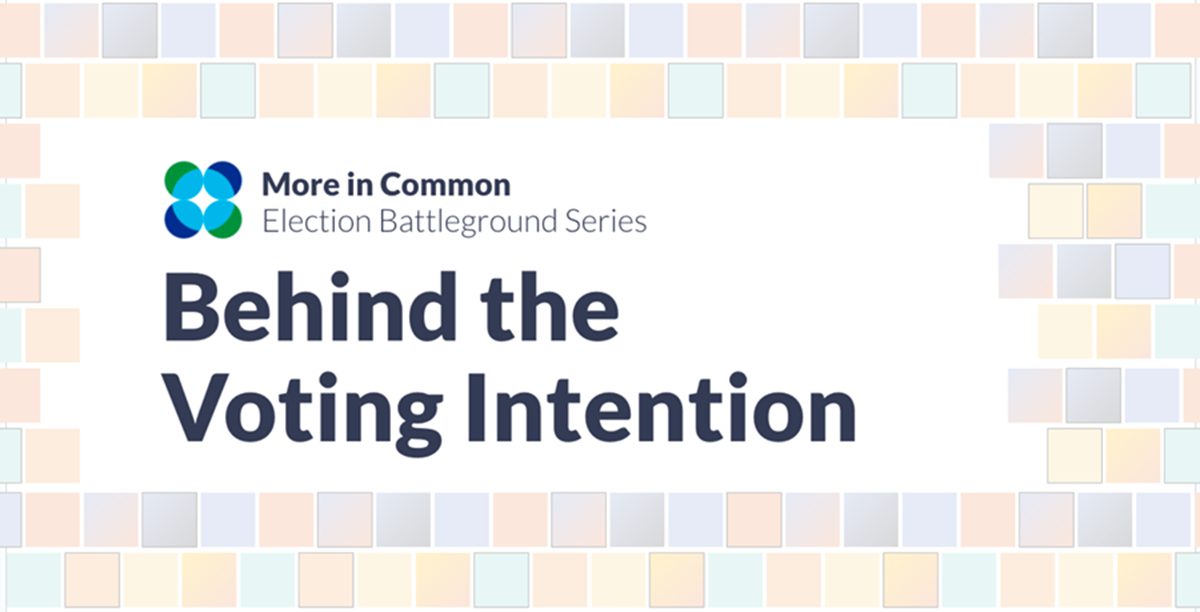Election Battleground Series

While headline voting intention for the major parties has remained stable for the past year, our new report ‘Behind the Voting Intention’ looks beyond these headline figures to identify eight key groups of voters who will determine who ends up with the keys to Downing Street.
Based on deep dive polling of voter priorities and testing of ‘mock manifestos’, the report looks at what the most important voter groups want to hear during the election campaign - including the ‘Don’t Knows’, voters who have switched from Conservative to Labour, and those who are backing Reform UK.
The report dives deep into the nuances of the views held by the British public that might not be captured through headline voting intention and dives deep into the eight key groups that will shape the outcome of the next general election.
More in Common's British Seven segments provide a unique lens into understanding how these voter groups compare to the UK public.
Using extensive polling of more than 3,000 people, 12 key insights stand out from the report:
More Tory voters have gone to “Don’t know” than switched to Labour
Direct switching between the two main parties is important, but far from the only dynamic at this election. Unlike previous elections the Don’t Knows are unusually Conservative in their profile.
Conservative 2019 voters have diverged, in part, on gender lines
The profile of voters who voted Conservative in 2019 but are now undecided is overwhelmingly female(~70%), older than average (61) and disproportionately likely to live in small towns or suburbs. These voters are key as where they ultimately give their support will decide the size and shape of any Labour victory.
Switchers don’t want tax cuts
Those who have switched directly from the Conservative to Labour Party are among the least likely to support tax cuts. Instead this group has a strong preference for greater investment in public services.
Cost of living remains dominant
Cost of living ranks as the number one issue facing the country - for every single voter group. Despite falling inflation it remains the most potent driver of support away from the Conservatives.
Culture wars aren’t vote winners
Big issues such as the cost of living, NHS, climate and immigration are far more significant in deciding people’s votes than issues like gender identity or political correctness. There is only a minority appeal for the European Convention on Human Rights (ECHR) withdrawal among the most right leaning voters.
Crime is increasingly salient
For the key swing voter groups tackling crime is among the top priorities for the next government. Less surprisingly, concerns about the NHS continue to dominate with waiting list horror stories a focus group staple.
Party leaders aren’t wowing voters
The party leaders are not a top draw for any of the key voter groups. People are more likely to be voting against a leader of another party than for their leader. This election will be about parties not personalities.
Liberal Democrats are anti-Tory voters
More so than other parties, Liberal Democrat voters are not motivated by specific policies, but instead a desire to get the Tories out. The profile of Liberal Democrat voters today is more ‘Social Democrat’ than Nick Clegg style ‘Orange Book Liberal'
Reform UK voters are unlikely to return to the Conservatives
The overwhelming reason that people are voting Reform UK is to protest Conservative policies on immigration. They are particularly ‘anti system’ - and are for instance the strongest supporters of House of Lords abolition. The Conservatives are unlikely to win many of them back.
Nigel Farage, not Richard Tice, is attracting people to Reform
The appeal of Nigel Farage is a significant driver of support among those planning on voting for the right wing party - other Reform figures do not have the same pull.
Labour’s second most popular policy with its supporters has now been scrapped
The £28bn climate investment pledge was popular with likely Labour voters. Other Labour policies - particularly removing private school tax breaks are also popular with their potential voter coalition.
The SNP is bleeding votes dramatically to Labour in Scotland
Since 2019, the SNP have lost 36 per cent of their voters - including 15 per cent to Labour, and a further 10 per cent to “the Don’t Knows”. Independence is the only glue keeping this group together.
For all the talk of a presidential-style election our research suggests that the next election is likely to be decided on policies rather than personalities. With the leaders a limited draw for supporters of any party. As this in-depth analysis suggests, the parties' fortunes are likely to be shaped by a series of factors that sit underneath headline voting intention - that includes the dominance of the cost of living, the rising salience of crime, what the unusually large number of undecided female voters who voted Tory in 2019, ultimately decide to do and to what extent third-party voters for the Greens, Liberal Democrats or Reform UK decide to vote tactically. Our study also contains a warning to both main parties on their policy platforms. With Tory hopes of winning back swing voters on a platform of tax cuts and creating a wedge on cultural issues is unlikely to move swing voters, while Labour risks reinforcing the charge they are more of the same by having ditched one of their most popular policies with their likely voters - the £28bn green investment. Our mock manifestos show the contenders for Number 10 need to do much more to convince the public they have the policies to fix broken Britain.
Luke Tryl, UK Director